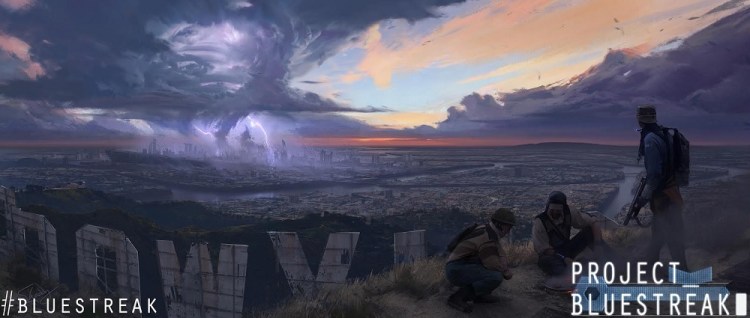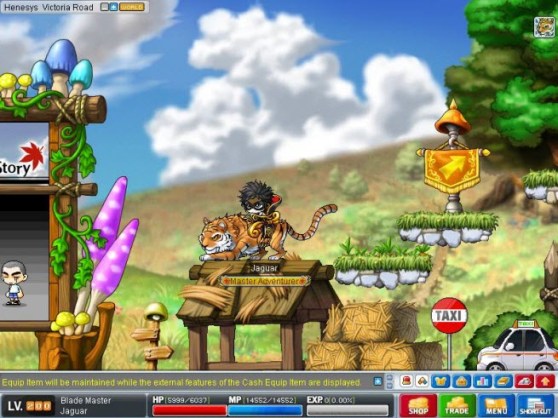GamesBeat: You guys do have experience in the shooter market. What do you think Nexon brings to the conversation there?
Mahoney: We have several shooters around the world. You’re probably familiar with Combat Arms in the U.S. In Korea the number one shooter is a game called Sudden Attack, one of our games. We’ve also worked with Valve for Counter-Strike Online, where they provided the IP and code and art assets and we built a free-to-play version for Korea, Japan, and China. That game has done very well.
Within those games, we’ve developed a whole lot of experience on how to do a free-to-play shooter and have it work well. Game balance is a big deal in a shooter – map design and so on. We’ve done a lot of experimentation to make that work well.
Every game is different. For example, in Counter-Strike Online in China, probably the most popular aspect of that is the zombie mode. It’s a lot of fun. People have responded well to that. But that came out of pure experimentation with different modes that people will love to play. That’s not a preview of anything that Cliff is doing. It’s just to say that we’ve learned from a lot of different experiences in a lot of different countries about what works well in a free-to-play shooter.
GamesBeat: It’s interesting that the Asian market is so different. I wonder how the content from these western developers is going to do over there.
Mahoney: It’s going to go on a case-by-case basis. There was a belief among western developers a few years ago that the core thing that was missing in Asia was graphics fidelity and physics. Based on the introduction of several western free-to-play games in the Asian market that have performed up to expectations, I think people are understanding that graphics fidelity is one point of differentiation, but core gameplay is much more important.
We see over and over again, someone in the west saying, “I look at those Asian games and they don’t look as good.” Then they introduce a game that to their eyes looks better, and they find that it doesn’t do well in Asia. Then they scratch their head and wonder why that’s the case. Graphical fidelity is one point of differentiation, but it’s not the primary point of differentiation. Often it’s maybe a couple or several rungs down from the top.
GamesBeat: The one that puzzles me a little is SmileGate’s CrossFire. Why is that doing so well out there?
Mahoney: I can’t speak for CrossFire because we don’t make it. But let’s use a different example. Why is Minecraft so popular among kids in the United States, kids who have so much graphical fidelity at their fingertips? My sons love to play Minecraft. They love to play Maple Story. They’re eight and 10. Neither of those games represent state-of-the-art graphics, and yet they love those games.
We’re already past the point of diminishing returns in graphical fidelity. That’s what we believe. It’s nothing against having great graphics. It’s just to say that having the same game as the other guy with more polygons is probably not such a great selling point anymore. You have to do something that’s much harder than throwing more polygons on the screen. You have to craft a great game where people say, “That game experience was a lot of fun.”
GamesBeat: Cliff noted that he valued creative freedom. I think you folks encourage that. I do wonder what happens when you have that conversation about a milestone that a developer’s supposed to hit and what happens if they miss it. How do you engage in that typical publisher-developer conversation?
Mahoney: It’s a couple of things. One, you start with a point of selection as far as the types of people you want to work with. This is probably going to sound naïve, but I don’t think it is. I think it comes from some hard-headed business sense. You need to be selective of the types of people you work with. Cliff did his due diligence on us and we certainly did it on Cliff. We asked ourselves a lot of questions. What does he care about? Is that in line with what we care about?
The second thing is, what are you really trying to get to? You have to ship a game, a great game. If you’re both in alignment on that, you’re probably going to come to the right solution. As far as creative freedom goes, for some people that may be a euphemism for spending five years developing a game and not getting it out the door. But when you’re selecting for people who want to ship great games, you’re going to start off the conversation pretty aligned.
We chose Cliff as a partner, and he chose us, because we both bring our respective expertise to the table. Once you bring that, you have to respect your partner’s expertise. We don’t want to get in the business of telling Cliff how to make a great game, telling him what he already knows. We expect Cliff to do that. We want to bring things that we know better. If you take your partnering philosophy as lead, follow, or get out of the way, you have to figure out what you lead with and what they lead with. Then you’re going to have a productive discussion.
Where I think developers and publishers start to have conflict, the publisher says, “No, you should make this color palette. You should tweak this in that way.” And the developer says, “No, I know more about this than you do. Let me work on it.” We’d certainly agree with that. The old stories, just to use an analogy from the movie business—There’s the old discussion about producers and writers and directors in conflict. The producer wants to be a director or a writer, so they want to make changes, and because they’re financing the movie they think that they should be able to do that. But the director needs the freedom to build the piece of art that they’d like. Those types of conflicts also happen in the games business.
What we’re doing is bringing our very unique, very specific, and very deep expertise to the table. Then we’re selecting partners who bring their own unique, specific, and deep expertise. We want to combine those all. What we don’t want to do is tell them something they already know.
GamesBeat: Cliff is starting to assemble his team. Do you watch that with interest as well?
Mahoney: Absolutely. We like to have high-bandwidth communication with everyone. We like to help where we can. But the great thing about Cliff, he knows what he wants. He knows how to go build it. If you look down the line of all the folks we’ve been partnering with, that’s true of all of them.
GamesBeat: In Cliff’s case, he retired from Epic. He probably cashed out pretty handsomely. It doesn’t seem like he necessarily needed someone else’s money to make games. When you have that situation, why do you still wind up having a relationship where one company is financing the other?
Mahoney: I can’t speak for his objectives. From our perspective, we’re willing to put time, effort, and in some cases money behind game-makers who we think are good, who have a viewpoint and have a lot to prove and have a lot to show the world.
GamesBeat: As far as timing goes, are there some things happening that make a game from Cliff ripe for the way the market’s turning right now?
Mahoney: I’ll answer that from a consumer’s perspective. You play a lot of games, right? You may or may not agree with this, but I can think of a lot of games that I’d like to play — different genres, better quality, different platforms, different online components. I can think of a lot of new features for games I like to play that I think would improve them. There’s a lot of room for more and better games.
When that happens, you bring back existing gamers. It’s not a static pie. You bring people who are inclined to play games into playing more games. You bring in gamers from other games that are not as good. You bring new gamers into the market.
To me the timing is always good. In the art business, it’s not a static business. There’s always room for creative improvement.
GamesBeat: Is there anything else exciting you that’s come up since we talked at E3?
Mahoney: Going back to a broader perspective, I think about six months ago you said that we were starting to get pretty interesting as a company. I don’t know if you still believe that, but I believe that. What’s exciting me is several things that we’re doing – both in terms of our internal studios, where we have several games we’ll be launching over the next 18 months, and also our external partnerships, where we also have several new games launching over the next 12 to 18 months.
Not all of those will be successful. I’m sure of that. I don’t know which will and won’t be, but in any group of games, some are going to be successful and some aren’t. But what you will find is that we’re raising the creative bar for online games around the world. We hope that what we’re doing is replicated by other companies. It’s going to make for a much more fun and exciting games industry.
We’re in the process of showing the world what a really fun online game is. I like our slate that’s coming out. As we launch those games, people can play them and tell us what they think. We’re going to be looking very hard at that feedback. It’s going to be pretty neat, certainly from a creative perspective. We’re working hard to do things that’ll make us proud, this year and five years or 10 years from now. We’ll be able to look back and say that we did some cool stuff.
VentureBeat's mission is to be a digital town square for technical decision-makers to gain knowledge about transformative enterprise technology and transact. Learn More




